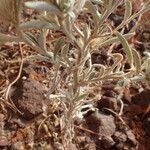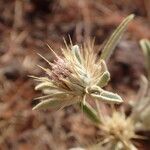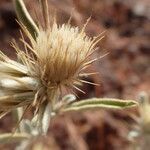Corollas creamy-white, 5–6 mm. long, lobes linear erect straight or recurved at the apex; achenes c. 2.5 mm. long, somewhat compressed turbinate, with c. 10 pronounced ± wing-like ribs, somewhat glutinous, ± densely long hispid-setose between the ribs, the hairs ± equalling achene in length and obscuring the surface, the basal hairs shorter more numerous and ± spreading; pappus copious, dimorphic, the outer series of slender barbellate setae 5–6 mm. long, the inner of c. 10 more robust narrowly scale-like setae 5–6 mm. long and broadly scarious-winged, barbellate near the apex.
Leaves discolorous, subsessile or midrib petiole-like in the lower c. 10 mm., mostly 10–75 x 3–12 mm., linear-elliptic to oblanceolate, often conduplicate, subacute to rounded mucronate or cuspidate at the apex, narrowly cuneate or attenuate below, callose-serrulate on the margins, green and thinly araneose to ± glabrescent on the upper surface, greyish-lanate beneath.
Phyllaries numerous, rigid dry-coriaceous, straight not reflexed, puberulous particularly the outer, usually purple-tinged with a darker purple stripe on either side of the midrib, margins sharply serrulate-ciliolate, from c. 3 mm. long and subulate outside to c. 18 mm. long and very narrowly triangular inside, apex long acuminate finely pungent.
Annual herb, up to 0.6 m high. Leaves oblanceolate or lorate, sometimes conduplicate, greyish lanate below, tapering into pseudopetiole, margin minutely callous-serrate. Heads discoid, axillary. Pappus barbellate, 2-seriate, outer slender, inner undulate-winged towards base. Flowers yellowish or whitish.
A herb. It grows 60 cm tall. It usually grows each year from seed. It has a woody base. The stems have a cottony coating. The leaves are narrow. They are 12-16 cm long by 1-2 cm wide. The flowers are in spiny heads and are pale pink.
Capitula numerous, subsessile or on short shoots, 1–15 arranged along each branch, singly or less often paired, subtended by 1–4 leaves.
Involucres mostly 12–20 mm. long with phyllaries diverging to 15–20 mm. in diam., loosely obconic-campanulate.
An annual weedy herb, usually branched from a woody base, up to 2 ft. high, with cottony stems and leaves
Stems purplish, branched above, leafy, greyish-white lanate to glabrescent.
Greenish-white to pale pink florets in spinose heads 1/2 in. or more long
An erect annual herb, 16–65 cm. tall.



